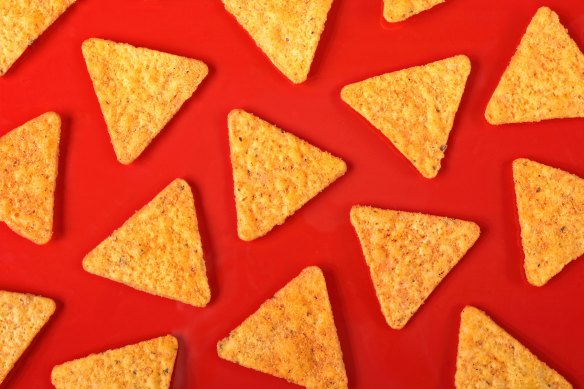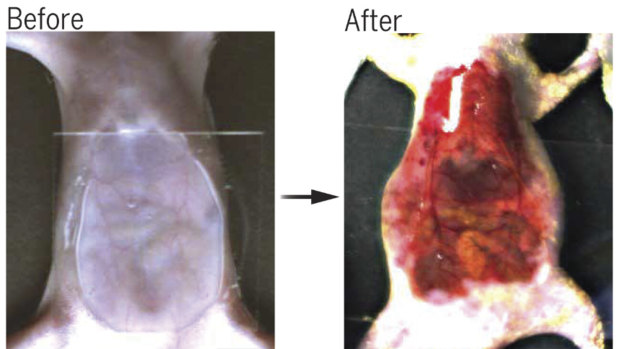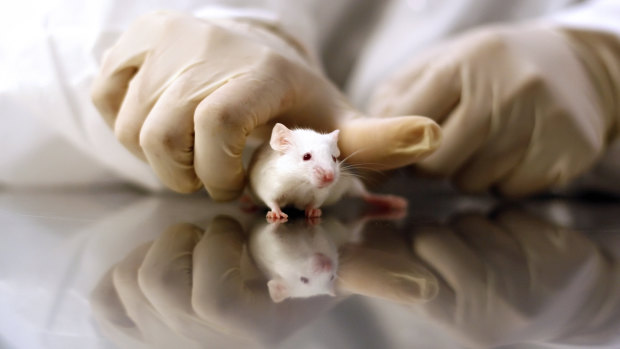This was published 10 months ago
‘Living window’: Food dye found in Doritos lets scientists see through mice
By Carolyn Y. Johnson
Washington: Scientists have discovered a surprisingly simple way to potentially peer inside the body, using a common yellow food dye found in Doritos to create see-through mice.
In a series of experiments that could have been plucked from the pages of science fiction, researchers at Stanford University massaged a solution containing tartrazine, the chemical found in the food dye known as “yellow No. 5” onto the stomachs, scalps and hind legs of mice. About five minutes later, the opaque skin of the mice transformed temporarily into a living window, revealing branching blood vessels, muscle fibres and contractions of the gut, they reported in the journal Science on Thursday.

Tartrazine, also known as Yellow No. 5, is a commonly used food dye.Credit: iStock
These results may sound like magic, but they are grounded in the basic science of optics – and are a major step forward in the long quest to see what’s beneath the surface of bodies without using a scalpel.
“You could see through the mouse. I’ve been working in optics for 30 years, and I thought that result was jaw-dropping,” said Adam Wax, a program officer who specialises in biophotonics at the National Science Foundation, one of the funders of the research.
The technique may help scientists answer long-standing questions in biology – for example, allowing researchers to observe a mouse’s brain activity, including in the deepest parts of the brain. It could be used to diagnose deep-seated tumours without surgery, help locate a vein for a blood draw or make cosmetic procedures like tattoo removal more precise, said Guosong Hong, a materials scientist at Stanford and one of the study’s leaders.

Tartrazine can render various samples transparent, including chicken breast tissue, and live mice bodies allowing for visualisation of a wide range of deep-seated structures and activities.Credit: Stanford University
“It’s not like Harry Potter. … We’re not making an actual invisibility cloak,” said Christopher Rowlands, a biophotonics researcher at Imperial College London who was not involved in the study but plans to try the technique in his lab. Even if this feat falls short of some of the most fantastical notions of invisibility, Rowlands said the new work was “a big deal” that allowed researchers to look 10 times deeper into living tissue with a simple topical application of a common food dye.
“If any of my colleagues aren’t excited, it’s because they didn’t understand the implications,” he said.

The solution was rubbed onto the stomachs, scalps and hind legs of mice to make them transparent.Credit: iStock
How does bright yellow food colouring turn tissue transparent? To understand why, it’s essential to consider the reason things look opaque in the first place. The bits of our body – cell membranes, proteins, fluids – all cause light to refract, or bend.
If light bends just once – think of a beam of sunlight hitting a sheet of glass – the image it carries is still mostly clear. But as light refracts over and over, off fluids, proteins and other cellular miscellany, it scatters in lots of directions. All that scattered light, Rowlands said, makes it hard to see through – “like watching TV through a glass of milk”.
In 1897, the science fiction writer H.G. Wells published The Invisible Man, the tale of a scientist who invented a serum to alter how the body’s cells refracted light, turning himself invisible. That’s conceptually similar to what the Stanford researchers did.
By applying textbook physics principles, the researchers were able to screen for molecules that they predicted would, when absorbed by the body, change how biological tissues refract light. They hit on tartrazine, dissolved in water. But the proof was in the experiment. They soaked a slice of raw chicken in a tartrazine solution and found that the chicken turned clear as they increased the amount of tartrazine. When they rubbed that solution onto the skin of mice, they saw internal organs come into view. The tartrazine reduced the amount of refraction, the light scattered less and the tissue appeared clear.
When the dye was washed off, the tissue returned to normal and the scientists reported “minimal systemic toxicity” in the mice. Even though tartrazine is used as a common food dye, this technique hasn’t been tested in humans, and it isn’t the sort of effect that would occur at the minuscule concentrations that happen when people get a little dust from flavoured chips on their hands.
Hong said his lab is not working with human tissues or subjects, and noted that experiments on humans require ethical approval, so it is unclear when researchers might try this technique on people. Rowlands said he was intrigued by the possibility of identifying other dyes that do the same thing at lower doses.
Francesco Pavone, a physicist who specialises in biophotonics at the University of Florence, said the study would start a race within the field to find applications.
“The final goal is to use on a human, and so far, we are limited,” Pavone said. “The biggest breakthrough I see here is it could be finally accessible to humans.”
The Washington Post